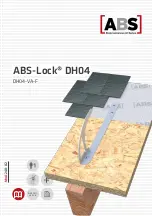
TEST OPERATION
The following quick test verifies the ST-400A is functioning properly.
1. Turn Pressure Switch knob to ON
2. Cover the lens for darkness
3. Verify a “double burst” flashing
4. Expose lens to light, Flasher stops flashing
5. Turn Pressure Switch knob to OFF, flasher stays off in the dark
6. ST-400A is ready to be deployed.
ADJUSTMENTS
To gain access to the electronic board, remove the top cap (bulkhead
connector end) on the pressure case by rotating the black Delrin cap
counterclockwise by hand. Only hand tight when reinstalling.
CAUTION: The ST-400A generates high voltage so do not operate it
without the protective sleeve around the electronic board.
SINGLE FLASH (disable “double burst”)
Remove black jumper on lower end of PC Board (end opposite the flash
tube). Battery life will increase by approximately 30%.
ADJUST FLASH RATE
Flash rate control location is marked on the yellow label — use a small flat
screwdriver to prevent damage to the control. Higher flash rate will de-
crease battery life (see graph, figure 2).
ADJUST INTENSITY (VISIBLE RANGE)
Intensity control location is marked on the yellow label. Increasing inten-
sity will decrease battery life (see graph, figure 2).
The measurement of light and the units used can be confusing and mislead-
ing. The standard in the marine industry is Effective Intensity measured in
Candelas. Tests were performed in clear nighttime conditions at sea. From
the resulting data, the following table was prepared.
Note: As conditions are highly variable, your actual range may be less than
the estimates in Table 1.
4
ST-400A
4. Test the operation by pressing the Cup Seal with your finger and listen
for the micro switch clicking as you press down firmly
5. Thoroughly lubricate the outer portion of the Cup Seal
6. Make sure the Delrin Knob carrier is clean and lubricated
7. Install the Delrin carrier
8. Lubricate the two socket head cap screws
9. Install Zinc Anode and secure with the two socket head cap screws. It
will be necessary to rotate the Delrin knob carrier to line up the
threaded holes in the aluminum body
Testing
1. Install the PS-200 on your equipment
2. Make sure the Unit is ON when the PS-200 ON/OFF knob is in the
ON position
3. Make sure the Unit is OFF when the PS-200 ON/OFF knob is in the
OFF position
CORROSION PREVENTION
Corrosion is a problem common to all metals used in the ocean. To help
minimize corrosion damage, the ST-400A is made with 6061-T6 aluminum
and is hard anodized; it is also fitted with a Zinc Anode. If the Zinc is more
than 50% wasted, replace it with part no. ZN-100. If the anodized surface
is damaged, pitted or gouged, protect it against further corrosion by apply-
ing tape, paint, or fast cure epoxy.
Several precautions can be taken prior to deployment to further minimize
corrosion:
•
Do not mount the flasher against metal.
•
Wrap the entire flasher with vinyl tape. Take care not to cover the hole in
the bottom of the Pressure Switch or the Zinc Anode.
•
Prevent the anodized surface from being scratched or damaged. Damage to
the anodized surface can cause pitting.
9
ST-400A
























